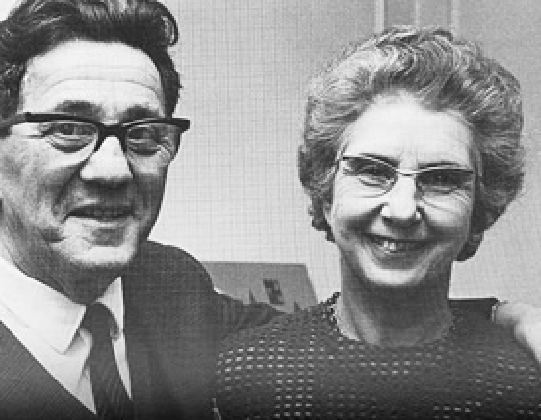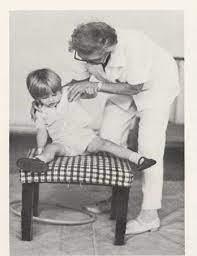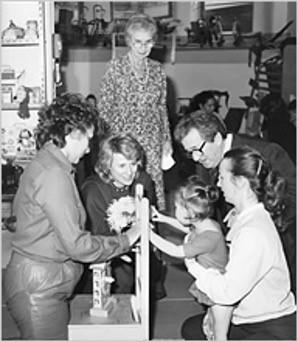Bobath Application in Cerebral Palsy
 Berta Bobath, a German Physiotherapist, worked with gymnastics teams early in her career. Mrs. Bobath, who started to work in the field of post-stroke rehabilitation in England, made a name for herself by supporting the well-known painter Simon Elwes to continue her career after stroke with this concept, which she laid with her husband, neurophysiologist and medical doctor Karel Bobath. He was especially interested in the rehabilitation of early, infancy and childhood brain injuries, and he established his first clinic in 1951 under the name of "Western Cerebral Palsy Centre". In this clinic, she continued her studies with the scientific contributions of her husband Karel Bobath and started to give trainings on the Bobath approach. In their 1956 article, Bertha and Karel Bobath stated that cerebral palsy rehabilitation should begin within the first 6 months of life. Later, with their studies, they tried to explain the effects of cerebral palsy on the motor abilities of the child and the limitations of these effects on the function, and they deepened their studies in order to minimize these negative effects and ensure that children are active in their lives.
Berta Bobath, a German Physiotherapist, worked with gymnastics teams early in her career. Mrs. Bobath, who started to work in the field of post-stroke rehabilitation in England, made a name for herself by supporting the well-known painter Simon Elwes to continue her career after stroke with this concept, which she laid with her husband, neurophysiologist and medical doctor Karel Bobath. He was especially interested in the rehabilitation of early, infancy and childhood brain injuries, and he established his first clinic in 1951 under the name of "Western Cerebral Palsy Centre". In this clinic, she continued her studies with the scientific contributions of her husband Karel Bobath and started to give trainings on the Bobath approach. In their 1956 article, Bertha and Karel Bobath stated that cerebral palsy rehabilitation should begin within the first 6 months of life. Later, with their studies, they tried to explain the effects of cerebral palsy on the motor abilities of the child and the limitations of these effects on the function, and they deepened their studies in order to minimize these negative effects and ensure that children are active in their lives.
The Bobath concept is a holistic rehabilitation approach to the child, which was created after these studies and is widely practiced today. This approach is a “living” approach that is constantly evolving by absorbing new information. Activity limitations arise from the complex interactions of the child's health status, personal factors, and the effects of the environment. The concept aims to provide the child with typical postural experiences, to reduce sensory deficiencies and to improve body structure and functions, thus increasing the level of independence in daily life. In the Bobath approach, it is aimed to reduce the child's activity limitations and increase participation and success by being effective in increasing motor performance, postural control and stability.

Bobath practice is not a set of standard exercises or practices that will remain in the same pattern, applied in the same way by all practitioners. Regardless of the degree of motor, sensory or cognitive impairment, this application, which can be applied to every child, evaluates children with certain reasoning ways. Then, each therapist (physical therapist, occupational therapist and speech language therapist who received 320 hours of basic Bobath training for 8 weeks) creates a special program for the functional limitations identified in the light of their clinical and scientific knowledge and experience. Bertha and Karel Bobath emphasized that they hope that the method will continue to develop and grow with this aspect. Today, the Bobath approach, which is applied based on modern scientific knowledge, continues to be the most widely used application in children and adults with cerebral palsy, infants at high risk of cerebral palsy and similar neurodevelopmental and neurological childhood-onset conditions in Europe and other countries, due to the high level of satisfaction of families.
In a systematic review written in 2022 (Cabezas-López 2022), three of the four randomized controlled trials comparing the Bobath method with other methods showed the Bobath method equally in a more advantageous study.

Today, Bobath Training is given under the umbrella of "The European Bobath Tutors' Association" (EBTA), which was established in 1971 with the participation of representatives from 5 countries to organize training on the method. Today, EBTA is represented in 18 countries, including our country. The trainings we organize as the Neurodevelopmental Therapy Therapists Association in our country are the trainings coordinated and planned together with the EBTA.
RESOURCES
1. Gunel MK. Cerebral Palsy: Current Steps: BoD–Books on Demand; 2016.
2. Bobath K, Bobath B. The diagnosis of cerebral palsy in infancy. Archives of disease in childhood. 1956;31(159):408.
3. Bobath B. The very early treatment of cerebral palsy. Developmental Medicine & Child Neurology. 1967;9(4):373-90.
4. https://en.wikipedia.org/wiki/Berta_Bobath
5. https://www.ebta.eu/whoweare/
6. The effects of Bobath therapy on children with cerebral palsy: a systematic review Mercedes Cabezas-López and Elena Bernabéu-Brotóns International Journal of Therapy and Rehabilitation 2022 29:7, 1-11